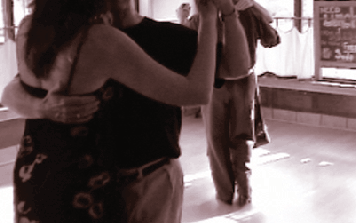
HOME
PUBLISHER’S CORNER
“A SENSORY BRIDGE TO GLOBAL CULTURE”


Advertise in:

AS WE INAUGURATE
TANGO LIFE & NEWS
TAKE ADVANTAGE OF OUR EXCLUSIVE
ONE-TIME OFFER TO PLACE YOUR AD HERE
FREE DURING NOVEMBER!
ADVERTISERS, DON’T MISS THIS CHANCE TO FEATURE
YOUR BUSINESS IN PREMIUM WEB SPACE
THAT WILL BE SEEN BY A GLOBAL AUDIENCE!
FOR DETAILS.
312.287.8406
AS A SPECIAL INTRODUCTORY BONUS, YOU’LL ALSO RECEIVE A DISCOUNT ON ADS PLACED THROUGH JANUARY 6, 2011.


“…even the basic movements resemble a caress or a request to engage in a meaningful dialogue. You’ve got to be ready to care for your partner – even love him – for that short period of time. To dance tango well…means making yourself vulnerable, vulnerable to the music and vulnerable to your partner, whether leading or following. Making oneself vulnerable means taking emotional risks and allowing exposure to intimacy – at least for three minutes at a time…How one handles the tango experience of vulnerability, though, can dramatically influence that dancer’s personal life.”
THE S P A C E
BETWEEN US
CONTINUES...CLICK HERE
PSYCHOLOGICAL PERSPECTIVES
ON THE DANCE OF RELATIONSHIP
THE S P A C E BETWEEN US
CONTINUED

TANGO CONNECTION
Confusion and ambiguity also arise about what it is to be male. Man’s historical tendency to admonish his female qualities has led to overall imbalance of energy on both sides.
Siegmann clarifies these gray areas. “Tango represents the very essence of the male and female energies; the dancers are the physical representation of these energies in each of us.” These energies are complimentary and equally powerful. The key to balance, both in the dance and in life, is for them to work symbiotically.
These male and female archetypes, what Carl Jung called anima and animus, co-exist in each of us and can be accessed when necessary. Although Siegmann relentlessly pursued this concept intellectually prior to tango, it was only though experiencing the dance in her own body that she was able to fully integrate and understand it.
The tango dance is a meeting of two human beings, coming together to explore their physical, psychic, energetic, and emotional connection to one another. Thomas writes that, in tango ―
Hawkes described the exploration of erotic realm as an important aspect of tango dancing. She noted that it’s important to differentiate sexual experience from sensual and erotic experiences which are more “subtle, rich, and vast.” Rarely is tango contact actually sexual in nature or intent.
Aline LaPierre conceptualized three phases that make up a sensual touch encounter. The first phase, “attunement and energetic bonding,” is characterized by exploration and “interactive attunement” to the partner’s desires, expectations, and needs. The partners heighten their awareness to each other’s rhythms, timing, and signals of readiness, and begin to synchronize their movements accordingly. This is where the foundation of the connection is assessed – trust and respect in the relationship will enable a deepening in the bond.13
In tango, this first phase is experienced as the two dancers come together in an embrace and begin their dance conversation. The two the distinct movement “voices”14 express themselves to one another in an attempt to become one unified voice. The ease of connection will vary greatly due to tango experience, capacity for bonding, and partner compatibility.
Inability to trust one’s partner or surrender to the care or needs of the other will serve as major roadblocks to bonding during this stage. It takes time to adapt to a partner – dancers may need several dances with a new partner to achieve this level of attunement and bonding, while others may have difficulty attaining it at all.
The second phase in LaPierre’s model, “intersubjective phase shift and resonance,”15 is when the mind drops away and each is immersed in the sensual experience:
“Once partners have reached a state of somatic trust and interactive attunement, a shift usually happens in the partners’ respective felt sense, and they each drop into a more acute awareness of each other’s erotic sensations…When the partners’ energy fields fall into resonance, both parties become aware of a shift in the depth and intensity of their inner experience…In this state of magnified sensory unity, partners surrender to nonverbal experience, and the mind can now let go and ride on the body’s pleasurable sensory currents…They are engaged in an energetic fusion often glowingly described as “being one”…When in alignment and moving together, couples experience that what pleases one pleases the other, and what is good for one is good for the other.”
While difficulties connecting in the first phase discourage many beginning Argentine tango students from continuing, those who persist into the second phase return to the dance in continuous pursuit to re-experience this “merger bliss.”16 Some argue that it is this sometimes elusive and transcendent “tango moment”17 that gives the tango its addictive quality.
Hawkes describes the importance of dancing with one another as “at once two persons and one dyad, with two contrasted aspects working together to form a whole yet remaining different so we do not merge into an undifferentiated mass.” She adds that the tango is a strong metaphor for the ability to be close but separate, where two partners must be intimately connected but clearly maintain their own role and personal expression.18
The third phase of a sensual encounter is closure and integration. Once both partners feel a sense of completion in their exchange, another shift occurs where the intensity dies down and the two selves within the partnership begin to separate into their respective entities. The thinking mind now rises to the surface attempting to integrate the experience with sense of self. Partners may offer loving words or gestures to express their feelings to one another about the exchange.19
